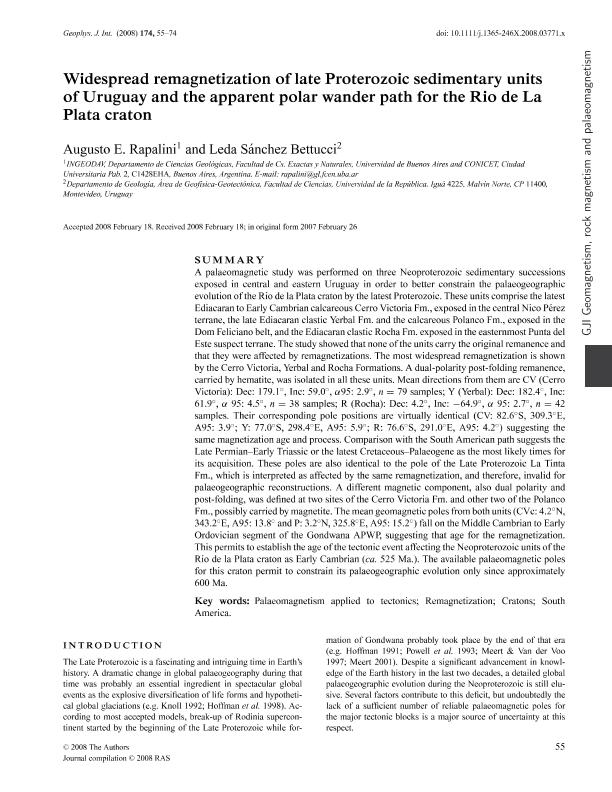Artículo
Widespread remagnetization of late Proterozoic sedimentary units of Uruguay and the apparent polar wander path for the Rio de La Plata craton
Fecha de publicación:
07/2008
Editorial:
Wiley Blackwell Publishing, Inc
Revista:
Geophysical Journal International
ISSN:
0956-540X
Idioma:
Inglés
Tipo de recurso:
Artículo publicado
Clasificación temática:
Resumen
A palaeomagnetic study was performed on three Neoproterozoic sedimentary successions exposed in central and eastern Uruguay in order to better constrain the palaeogeographic evolution of the Río de la Plata craton by the latest Proterozoic. These units comprise the latest Ediacaran to Early Cambrian calcareous Cerro Victoria Fm., exposed in the central Nico Pérez terrane, the late Ediacaran clastic Yerbal Fm. and the calcareous Polanco Fm., exposed in the Dom Feliciano belt, and the Ediacaran clastic Rocha Fm. exposed in the easternmost Punta del Este suspect terrane. The study showed that none of the units carry the original remanence and that they were affected by remagnetizations. The most widespread remagnetization is shown by the Cerro Victoria, Yerbal and Rocha Formations. A dual-polarity post-folding remanence, carried by hematite, was isolated in all these units. Mean directions from them are CV (Cerro Victoria): Dec: 179.1°, Inc: 59.0°, α95: 2.9°, n = 79 samples; Y (Yerbal): Dec: 182.4°, Inc: 61.9°, α 95: 4.5°, n = 38 samples; R (Rocha): Dec: 4.2°, Inc: -64.9°, α 95: 2.7°, n = 42 samples. Their corresponding pole positions are virtually identical (CV: 82.6°S, 309.3°E, A95: 3.9° Y: 77.0°S, 298.4°E, A95: 5.9° R: 76.6°S, 291.0°E, A95: 4.2°) suggesting the same magnetization age and process. Comparison with the South American path suggests the Late Permian-Early Triassic or the latest Cretaceous-Palaeogene as the most likely times for its acquisition. These poles are also identical to the pole of the Late Proterozoic La Tinta Fm., which is interpreted as affected by the same remagnetization, and therefore, invalid for palaeogeographic reconstructions. A different magnetic component, also dual polarity and post-folding, was defined at two sites of the Cerro Victoria Fm. and other two of the Polanco Fm., possibly carried by magnetite. The mean geomagnetic poles from both units (CVc: 4.2°N, 343.2°E, A95: 13.8° and P: 3.2°N, 325.8°E, A95: 15.2°) fall on the Middle Cambrian to Early Ordovician segment of the Gondwana APWP, suggesting that age for the remagnetization. This permits to establish the age of the tectonic event affecting the Neoproterozoic units of the Río de la Plata craton as Early Cambrian (ca. 525 Ma.). The available palaeomagnetic poles for this craton permit to constrain its palaeogeographic evolution only since approximately 600 Ma. © 2008 The Authors Journal compilation
Palabras clave:
Cratons
,
Palaeomagnetism Applied to Tectonics
,
Remagnetization
,
Southamerica
Archivos asociados
Licencia
Identificadores
Colecciones
Articulos(IGEBA)
Articulos de INSTITUTO DE GEOCIENCIAS BASICAS, APLICADAS Y AMBIENTALES DE BS. AS
Articulos de INSTITUTO DE GEOCIENCIAS BASICAS, APLICADAS Y AMBIENTALES DE BS. AS
Citación
Rapalini, Augusto Ernesto; Bettucci Sanchez, Leda; Widespread remagnetization of late Proterozoic sedimentary units of Uruguay and the apparent polar wander path for the Rio de La Plata craton; Wiley Blackwell Publishing, Inc; Geophysical Journal International; 174; 1; 7-2008; 55-74
Compartir
Altmétricas




